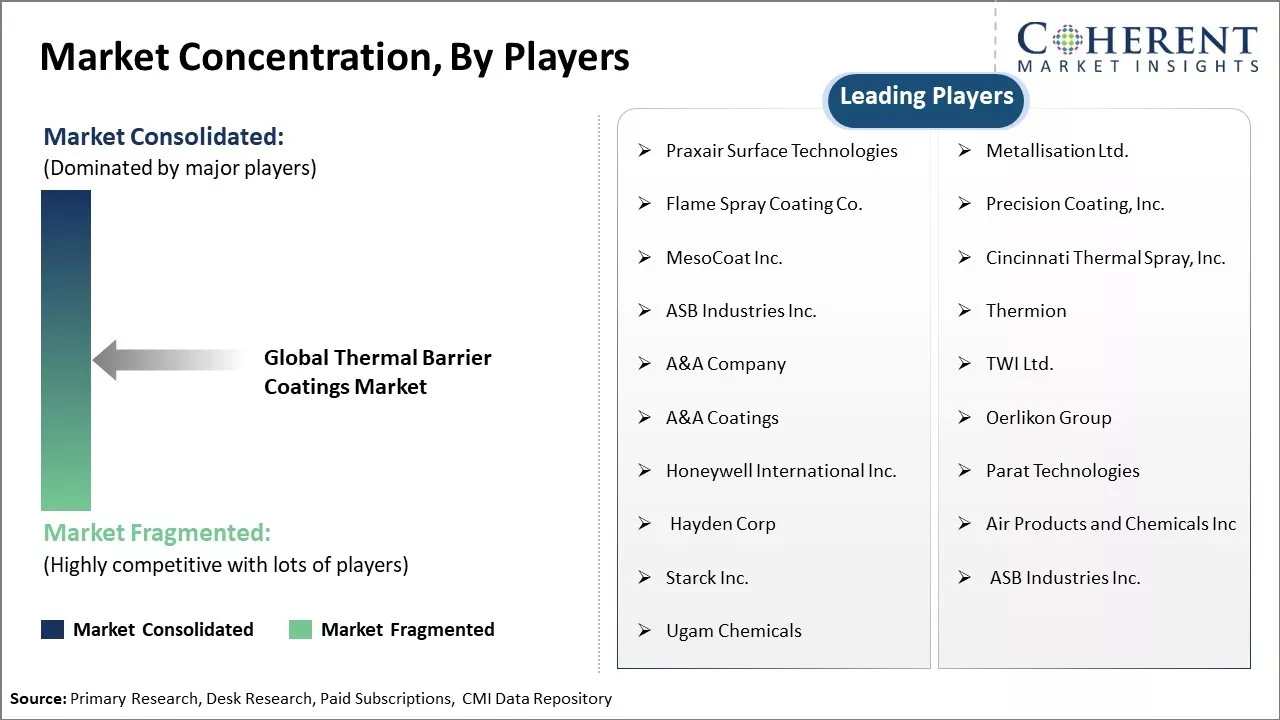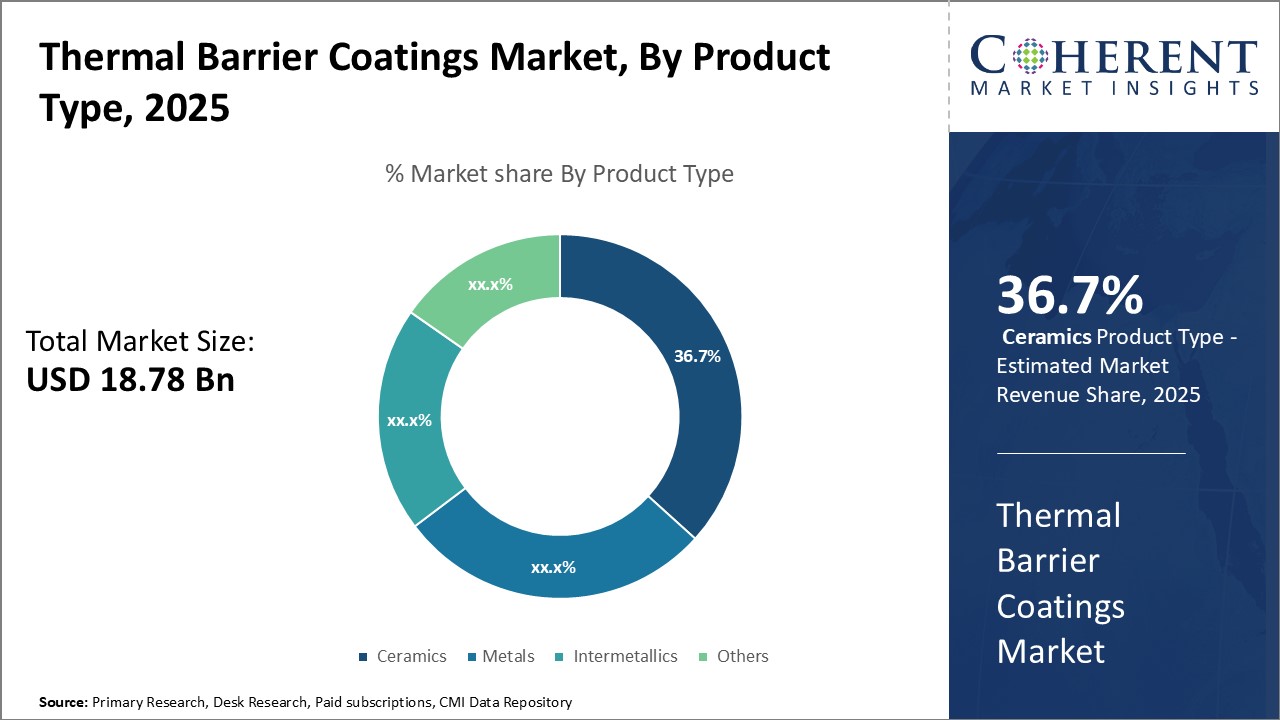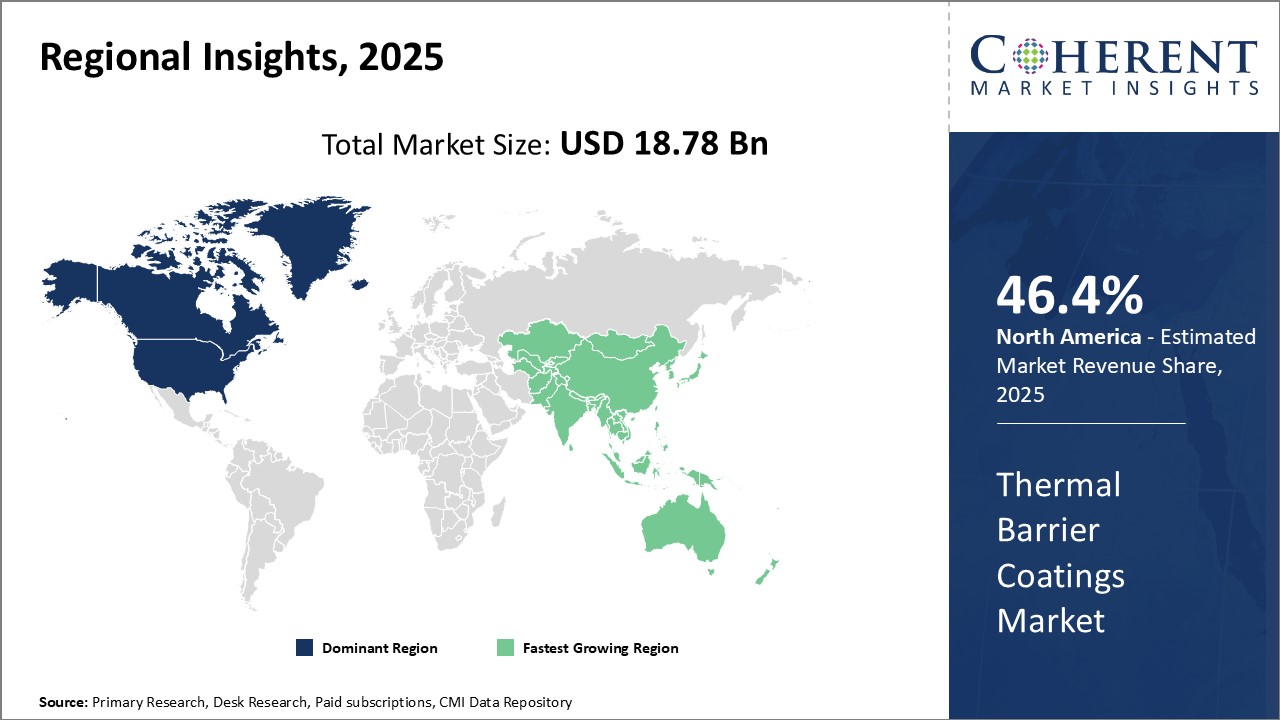The thermal barrier coatings market is estimated to be valued at USD 18.78 Bn in 2025 and is expected to reach USD 27.16 Bn by 2032, exhibiting a compound annual growth rate (CAGR) of 5.4% from 2025 to 2032.

Discover market dynamics shaping the industry: Download Free Sample
Rising demand from industries, such as power generation, aerospace, and automotive, is expected to drive the market growth. In the power generation industry, thermal barrier coatings prevent components like turbine blades from overheating, allowing turbines to operate more efficiently at higher temperatures. In the aerospace and automotive industries, thermal barrier coatings help increase the fuel efficiency and performance of engines by allowing engines to operate at higher combustion temperatures. Growing demand for fuel efficient vehicles and need for power generation from clean energy sources is expected to boost the demand for thermal barrier coatings during the forecast period.
Emerging use in new industrial and commercial applications
The use of thermal barrier coatings is expected to significantly grow in new industrial sectors in the coming years. TBCs are increasingly being used in various applications that require components to withstand high temperatures for extended periods of time. With advancements in material science and coating technologies, these protective coatings can now be effectively applied on components used in industries like diesel engines, gas turbines, aluminum casting, etc.
Especially, thermal spray coatings are emerging as a game changer for components used in locations where temperatures frequently exceed 500 degrees Celsius. Their ability to prevent heat transfer and protect substrates from corrosion, oxidation, and thermal fatigue is enabling the broader use of TBCs in the automotive, energy, and manufacturing sectors. For example, in diesel engines TBC coated parts are allowing higher compression ratios and combustion temperatures for better fuel efficiency. Similarly, coatings on blades and vanes of industrial gas turbines are supporting higher operating temperatures for maximized output and efficiency. Even components used in aluminum casting and die-casting are benefiting from protective thermal barrier coatings for improved productivity and quality.
Research is also ongoing to develop next generation coating materials and application techniques to facilitate the use of TBCs in newer industrial processes involving high heat. This includes exploring ceramics, rare earth oxides, and non-line-of-sight coating technologies. The goal is to offer coatings solutions for applications in advanced manufacturing like 3D printing, laser cladding, and heat treatment of special alloys that require localized heat management. Once commercially viable solutions emerge, they can open up whole new domains for thermal barrier coatings beyond traditional usages. This potential for expanding into new industrial segments with evolving needs will be a key driver of future demand.

Get actionable strategies to beat competition: Download Free Sample
Stringent emission regulations on combustion systems
Growing concerns about environmental pollution and climate change are prompting governments worldwide to introduce increasingly stringent emission norms for engines and industrial combustion systems. This regulatory pressure is direct forcing the operators of diesel systems, boilers, furnaces, and heat treatment equipment to optimize combustion processes for lower greenhouse gas and toxic emissions. One of the most important strategies adopted towards this end is lifting maximum operating temperatures of systems through effective heat management.
This is where thermal barrier coatings come into play as they help combustion equipment run at higher temperatures without damage to internal parts. The higher ignition and combustion temperatures allowed by TBC coated components result in more complete fuel burn and reduced formation of pollutants.
Key Takeaways from Analyst:
The thermal barrier coatings market is expected to experience steady growth in the coming years. The market is driven by the increasing application of thermal barrier coatings in industries such as aerospace, industrial gas turbines, and automotive. Thermal barrier coatings provide protection to parts in high temperature applications by reducing heat transfer. This improves component life and performance.
Thermal barrier coatings find major use in aircraft engines and parts to sustain extreme operating temperatures. Rising application of gas turbines for power generation is another driver as thermal protective coatings help increase the turbine efficiency.
Stringent environmental regulations pose a challenge. The manufacturing process of some thermal barrier coatings produces hazardous waste which requires safe disposal. High material and production costs could also limit adoption in price sensitive applications.
Opportunities lie in developing advanced coating materials with longer lifespan and higher temperature resistance. This would improve process efficiency. Growth of the automotive industry particularly in Asia Pacific presents an avenue as turbocharged vehicles increase the demand for heat resistant components. Rising MRO activities in aviation also ensures aftermarket opportunities.
Market Challenges: High procurement cost
The high procurement cost associated with thermal barrier coatings is significantly restraining the growth of the global market. Thermal barrier coatings are specifically engineered material systems used to provide thermal insulation as well as protect expensive metal alloy components that operate at high temperatures, from melting or corroding. However, developing and producing these specialized coating materials and application processes requires extensive research and developmental investments. The coating materials often involve complex synthesized ceramic compounds or mixed metal alloys which are expensive to produce. Further, the application of these coatings requires specialized thermal spray or physical/chemical vapor deposition equipment which have high set up and recurring costs.
Market Opportunities: Development of next generation coatings
The development of next generation coatings is posing a significant restraint to the growth of the global thermal barrier coatings market. Thermal barrier coatings have been traditionally used in high-temperature applications such as turbines, engines and furnaces to provide insulation to underlying components and increase their operational life. However, continuous research and development towards alternative insulation solutions has started yielding new coating technologies that provide better heat resistance compared to traditional thermal barrier coatings.

Discover high revenue pocket segments and roadmap to it: Download Free Sample
Insights by product type: Thermal compatibility drives growth in the ceramics segment
In terms of product type, ceramics is expected to contribute 36.7% share of the market in 2025, owing to its ability to withstand high thermal stresses and compatibility with a wide range of substrate materials. Ceramic coatings exhibit higher thermal expansion coefficient matching with metal alloys used in gas turbine components like blades and nozzles. This thermal compatibility allows ceramics to effectively insulate the underlying superalloys from extreme combustion temperatures in jet engines and power plants. Ceramic coatings like zirconia partially stabilized with yttria (YSZ) and alumina (Al2O3) possess high resistance to sintering and creep at elevated temperatures making them suitable for applications with continuous firing at 800°C or above. Their inertness to corrosion and oxidation in hostile environments further reinforces the use of ceramics as durable thermal barrier coatings.
Insights by coating materials: AL2O3 retains its edge due to proven performance record
In terms of coating materials, AL2O3 is expected to contribute 40.8% share of the market in 2025, owing to its well-established performance history. Alumina ceramics demonstrate high hardness, chemical stability, and mechanical strength at high operating temperatures. Continuous research over the last few decades have improved deposition techniques and bond coating designs to overcome the shortcomings of thermal fatigue in early AL2O3 coatings. Today, modifications like addition of dopants and multifunctional layered designs have enhanced the cyclic spallation resistance of AL2O3, allowing it to serve for over 50,000 hours in gas turbine combustors without losing integrity. The wealth of performance data on AL2O3 helps aero-engine manufacturers to confidently specify it for new engine development programs. Its simple processing also makes AL2O3 more economical relative to newer coatings, further galvanizing its popularity among commercial suppliers.
Insights by technology: HVOF excels in deposition control and adherence
In terms of technology, HVOF is expected to contribute 36.1% share of the market in 2025, owing to its unique advantage of depositing coatings with controlled microstructure and strong mechanical interlocking with the substrate. The HVOF process involves a high velocity oxygen-fuel thermal spray, where fuel and oxygen are ignited to produce a supersonic combustion gas jet capable of accelerating powder particles to very high velocities. On impact, these particles deform plastically to embed themselves firmly onto the part being coated. This deposition mechanism results in dense coatings with low oxide content and residual stresses. It allows manipulating the coating structure to achieve lower porosity and higher hardness compared to alternative methods like plasma spraying. HVOF techniques also codeposit bond coat materials with the top coat ceramics, promoting a graded interface less prone to delamination. Thermal fatigue experiments have demonstrated that parts coated by HVOF last 3-5 times longer than those treated with other spraying technologies.

Need a Different Region or Segment? Download Free Sample
North America has established itself as the dominant region in the global thermal barrier coatings market. The region is expected to account for 46.4% share in 2025. With the presence of leading aerospace companies, North America accounts for the largest share of commercial aircraft fleet and aircraft engine manufacturing. Major cities like Seattle, Los Angeles, and Chicago are hubs for aircraft parts production and engine manufacturing which generates high demand for thermal barrier coatings. The region is also home to well-established coating manufacturers who can cater to the stringent quality and testing requirements of the aerospace industry. Many international companies have set up manufacturing plants in the U.S. to serve the domestic market as well as export to other regions. Further, the positive economic outlook and rising passenger traffic in the region has prompted aircraft manufacturers to boost production, thereby driving the consumption of coatings.
The Asia Pacific region has emerged as the fastest growing market for thermal barrier coatings in recent years. Several factors such as the rapid growth of the aerospace industry and rising income levels are contributing to the growth of the market. Many international aircraft manufacturers have established assembly plants in countries like China, India, and Japan to gain access to low-cost skilled labor and larger addressable domestic markets. The region is expected to witness increased localized coating production to serve the demand from these domestic aircraft assembly facilities. Additionally, Asia Pacific is a major manufacturing hub for gas turbines used in power generation industries. The increasing investment in power projects across developing Asian countries will stimulate the demand for gas turbines and thermal barrier coatings. Countries like China and India also have a sizeable presence of manufacturing industries that use gas turbines for process heating and require protective coatings. The region therefore presents lucrative opportunities for both international and domestic coatings producers to expand their footprints.
Thermal Barrier Coatings Market Report Coverage
| Report Coverage | Details | ||
|---|---|---|---|
| Base Year: | 2024 | Market Size in 2025: | USD 18.78 Bn |
| Historical Data for: | 2020 To 2024 | Forecast Period: | 2025 To 2032 |
| Forecast Period 2025 to 2032 CAGR: | 5.4% | 2032 Value Projection: | USD 27.16 Bn |
| Geographies covered: |
|
||
| Segments covered: |
|
||
| Companies covered: |
Praxair Surface Technologies, Metallisation Ltd., Flame Spray Coating Co., Precision Coating, Inc., MesoCoat Inc., Cincinnati Thermal Spray, Inc., ASB Industries Inc., Thermion, A&A Company, TWI Ltd., A&A Coatings, Oerlikon Group, Honeywell International Inc., Parat Technologies, Hayden Corp, Air Products and Chemicals Inc, Starck Inc., ASB Industries Inc., and Ugam Chemicals |
||
| Growth Drivers: |
|
||
| Restraints & Challenges: |
|
||
Uncover macros and micros vetted on 75+ parameters: Get instant access to report
*Definition: Thermal barrier coatings market provides protective coatings for metallic surfaces that are exposed to high temperatures, such as turbine engine components. These coatings help improve component durability, reliability and enhance performance by providing insulation that allows the underlying substrate to operate at a lower temperature. Thermal barrier coatings are typically ceramic-based and provide resistance against heat, wear, and corrosion, enabling enhanced lifespan and efficiency for equipment operating in high-temperature applications.
Share
Share
About Author
Yash Doshi is a Senior Management Consultant. He has 12+ years of experience in conducting research and handling consulting projects across verticals in APAC, EMEA, and the Americas.
He brings strong acumen in helping chemical companies navigate complex challenges and identify growth opportunities. He has deep expertise across the chemicals value chain, including commodity, specialty and fine chemicals, plastics and polymers, and petrochemicals. Yash is a sought-after speaker at industry conferences and contributes to various publications on topics related commodity, specialty and fine chemicals, plastics and polymers, and petrochemicals.
Missing comfort of reading report in your local language? Find your preferred language :
Transform your Strategy with Exclusive Trending Reports :
Frequently Asked Questions
Joining thousands of companies around the world committed to making the Excellent Business Solutions.
View All Our Clients